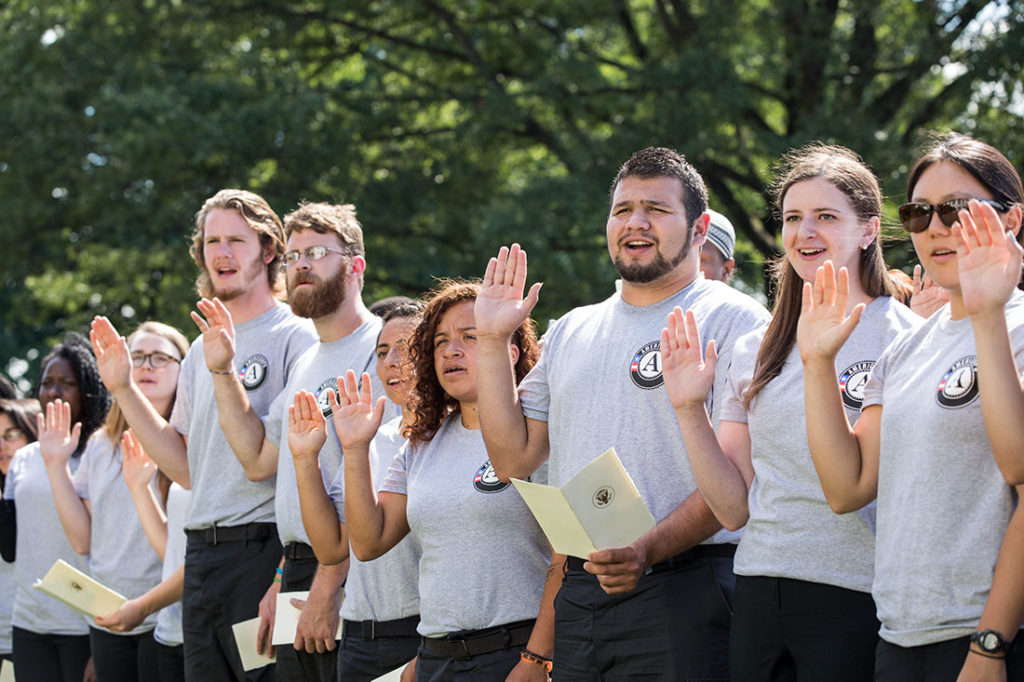Student-centric advice and objective recommendations
Higher education has never been more confusing or expensive. Our goal is to help you navigate the very big decisions related to higher ed with objective information and expert advice. Each piece of content on the site is original, based on extensive research, and reviewed by multiple editors, including a subject matter expert. This ensures that all of our content is up-to-date, useful, accurate, and thorough.
Our reviews and recommendations are based on extensive research, testing, and feedback. We may receive commission from links on our website, but that doesn’t affect our editors’ opinions. Our marketing partners don’t review, approve or endorse our editorial content. It’s accurate to the best of our knowledge when posted. You can find a complete list of our partners here.
Doing Good and Saving Money Through AmeriCorps
 By
Will Geiger
By
Will Geiger 
Will Geiger is the co-founder of Scholarships360 and has a decade of experience in college admissions and financial aid. He is a former Senior Assistant Director of Admissions at Kenyon College where he personally reviewed 10,000 admissions applications and essays. Will also managed the Kenyon College merit scholarship program and served on the financial aid appeals committee. He has also worked as an Associate Director of College Counseling at a high school in New Haven, Connecticut. Will earned his master’s in education from the University of Pennsylvania and received his undergraduate degree in history from Wake Forest University.
Full BioLearn about our editorial policies

Are you considering taking a gap year and looking into ways that you can give back to the world during your year off school? If so, consider AmeriCorps! AmeriCorps is basically the domestic branch of the Peace Corps. It allows high school graduates to participate in different types of years of service across the country. It may even qualify you for educational stipends to put towards their college education!
Let’s get into the specifics of some different AmeriCorps programs, discuss what they entail, and help you decide whether they are a good fit for your situation!
Also see: How to find a job after graduating college
Three branches of AmeriCorps
AmeriCorps offers three different programs for participants:
- State and National
- National Civilian Community Corps (NCCC)
- Volunteers in Service to America (VISTA)
These two first options are ideal for students taking a gap year. That’s because they do not require college education or work experience. The VISTA program generally requires either a college degree or work experience in the field of the program. So, it is less feasible as an option for your typical gap year student.
Let’s break each of these programs down. We’ll discuss what types of programs you can find with them, how you can help fund your education with the stipend, and the process for applying.
AmeriCorps State and National
AmeriCorps State and National is an incredibly versatile program with partner organizations all across the country. Volunteers serve their State and National program over the period of one year, and they can choose whether to participate part-time or full-time. This is incredibly useful, as students who choose to do part-time can accept another part-time job to help make the program work financially.
AmeriCorps State and National has a long list of partner organizations all across the country, and instead of applying to the central AmeriCorps entity, applicants apply directly to these organizations, so requirements can vary based on where you’re applying. The only base requirements that apply to each program are that the applicant be at least 17 years old. You can search through a list of State & National programs right on the AmeriCorps website.
Living allowance
Although AmeriCorps is a volunteer program, so its participants should not expect to obtain any substantial savings, it does offer a living allowance to help participants break even. These living allowances will vary based on the program you enroll in, but the central organization has set a minimum allotment of $22,000 a year for full-time members.
On top of this, some programs will provide housing for you, while others will not. When it comes down to it, many of these factors will vary purely based on the program you choose.
Educational award
Those who successfully complete their year of volunteering will receive the Segal AmeriCorps award, which varies in amount by member. You can apply this towards qualifying future or past educational expenses. What’s more, you are eligible to defer your federal student loans during your service. AmeriCorps will pay back all interest that might gather on them during this time.
Related: Top community service scholarships
National Civilian Community Corps (NCCC)
NCCC varies from the State and National Program in a few ways. First, the minimum age is 18 rather than 17. Anyone over the age of 18 can participate as a Team Member, yet the more involved position of Corps Member is reserved for those between the ages of 18 and 26. What’s more, the program is more centralized and rather than applying to an individual organization, you’ll be applying to the AmeriCorps organization as a whole.
While State and National Programs appoint you to a specific organization for the entirety of your year, NCCC involves a bit more variety. You’ll instead be matched with a group of volunteers and receive a “home base” – a region in which you will serve a wide variety of different organizations. So, you’ll rotate between these over the course of your service, which typically lasts 10 months.
Unlike State and National programs, which have deadlines that rotate throughout the year based on the organization you apply to, NCCC has a few different deadlines per year based on the season in which you want to start. Find their application information on their website.
Living allowance
NCCC participants receive about $4,000 over the course of their 10-month service, in addition to room and board. This may vary slightly by program and by year.
Educational award
Those who complete the program are eligible for an educational award of over $6,000. You can apply this award to future educational expenses or to repay qualifying student loans. What’s more, you can defer any student loans you already have taken out for the entirety of your program. AmeriCorps will reimburse you for any interest that gathers during the time.
Volunteers in Service to America (VISTA)
As mentioned before, the VISTA program is generally populated by college graduates or people with more experience in the field than a gap-year participant would have. So, unless you fit into one of these categories, you’re best off just considering the previous two options.
VISTA has partner organizations across the country that they match volunteers with. Participants receive a modest living stipend, professional career training, and the option of an additional cash stipend or an educational stipend. Like the National and State Program, applicants send their applications directly to the organizations they want to work for. So, you’ll find out on a case-by-case basis who might accept you. Check out the benefits of the VISTA program below!
Living allowance
The living allowance can vary based on location and organization, so be sure to check in with your organization before deciding. Typically, each will be just enough to meet the basic costs of living.
Educational award
Those who complete the program can choose between an educational award of approximately $7,395 to pay for future expenses or student loans, or a cash stipend for $1,800.
Professional development
Unlike the other AmeriCorps programs, which are meant purely to offer volunteer experience to those in need, VISTAs receive professional training from their organizations. This helps them to land a job and potentially career in the field upon completion of the program. So, if you have completed your schooling or qualify otherwise for a VISTA program, it may be the best option for you if you hope to build your resume.
Don’t miss: Top leadership scholarships
So, which is right for me?
When it comes down to it, there are a few key differences that can determine which program to choose for students. If you are looking to settle down in one place and at one organization during your gap year, the State and National program is probably your best bet. If you love mixing things up, working as part of a large team, and gaining a wide variety of different experiences, NCCC might be the right fit. And if you are not looking for a gap year, but rather, a year of service after graduation, the VISTA program is probably a good fit.
Recent graduates may also opt for an NCCC program if they want the experience of working at many different organizations. However, VISTA programs are oftentimes a better option for resume development and the potential to find a future career.
Also see: Top scholarships for high school seniors
Frequently asked questions
Does AmeriCorps pay well?
These educational benefits can go towards future educational expenses or to pay back qualifying student loans that you’ve already taken out. What’s more, if you have loans at the time of beginning the program, as long as they are federal, you can have them deferred, and the program will repay any interest that they gather during this time.
Does AmeriCorps provide housing?
Can you choose your own AmeriCorps location?
What is the AmeriCorps living allowance?
Does AmeriCorps look good on a resume?
Furthermore, as the actual content of AmeriCorps programs can vary widely, some experiences will be more applicable than others. If you have an idea of your future career prospects, try to find a program that fits with your priorities. This way you can use it as an asset on your resume down the line.
Can I defer my college admission to participate in AmeriCorps?



